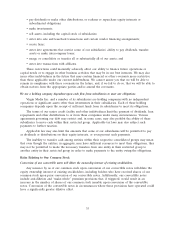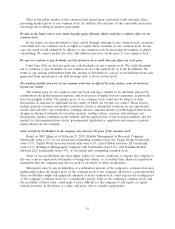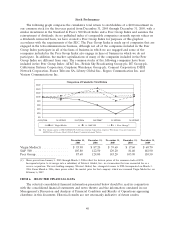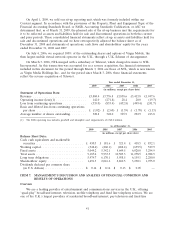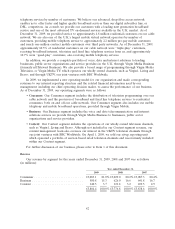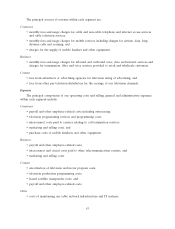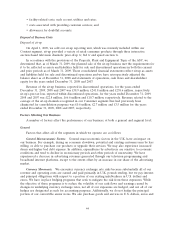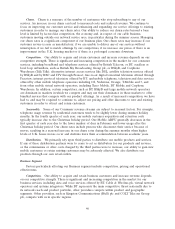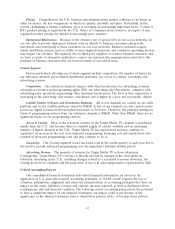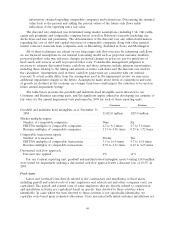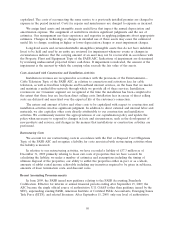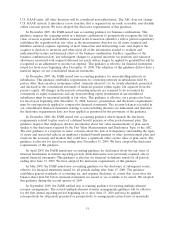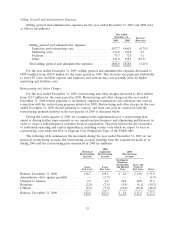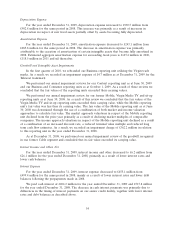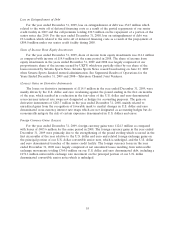Virgin Media 2009 Annual Report Download - page 47
Download and view the complete annual report
Please find page 47 of the 2009 Virgin Media annual report below. You can navigate through the pages in the report by either clicking on the pages listed below, or by using the keyword search tool below to find specific information within the annual report.South African rand, such as TV programming, customer premise equipment and network maintenance
services and most of these exposures are not hedged.
Integration and Restructuring Activities. In the fourth quarter of 2008, we commenced the
implementation of a restructuring plan aimed at driving further improvements in our operational
performance and eliminating inefficiencies in order to create a fully-integrated, customer-focused
organization. We anticipate significant cost savings from the plan and that the annual savings from and
after 2010 will exceed the annual costs incurred in connection with the plan. These costs will include
purchases of fixed assets, lease and contract exit costs, employee termination costs and other
restructuring and restructuring-related expenses, some of which will be classified as restructuring costs.
In total, we expect to incur operating expenditures of between £140 million to £155 million and capital
expenditures of between £40 million to £45 million in connection with this plan over a three-year
period. Our financial performance may be negatively affected if we are unable to implement our
restructuring plan successfully and realize the anticipated benefits.
Capital Expenditures. Our business requires substantial capital expenditures on a continuing basis
for various purposes, including expanding, maintaining and upgrading our cable network, investing in
new customer acquisitions, and offering new services. If we do not continue to invest in our network
and in new technologies, our ability to retain and acquire customers may be hindered. Therefore, our
liquidity and the availability of cash to fund capital projects are important drivers of our revenue.
When our liquidity is restricted, so is our ability to meet our capital expenditure requirements.
Consumer Segment
In our Consumer segment, cable customers account for the majority of our revenue. The number
of customers, the number and types of services that each customer uses and the prices we charge for
these services drive our revenue. Our profit is driven by the relative margins on the types of services we
provide to these customers and by the number of services that we provide to them and, with respect to
our fixed and mobile telephone customers, by usage levels of our services. For example, cable
broadband internet is more profitable than our television services and, on average, our ‘‘triple-play’’
customers are more profitable than ‘‘double-play’’ or ‘‘single-play’’ customers. Similarly, over the service
term our contract mobile customers are more profitable than our prepay mobile customers, and
provide a better opportunity for cross-sell of our cable products. We actively promote ‘‘quad-play’’
services and our packaging of services and our pricing are designed to encourage our customers to use
multiple services such as television, fixed and mobile telephone and broadband at a lower price than
each stand-alone product on a combined basis. Factors particularly affecting our Consumer segment
include average revenue per user, or ARPU, churn, competition, seasonality and distribution.
Cable ARPU. Cable ARPU is a measure we use to evaluate how effectively we are realizing
potential revenue from our residential cable customers on our network. We believe that our ‘‘triple-
play’’ cable offering of television, broadband and fixed line telephone services is attractive to our
existing cable customer base and generally allows us to increase our cable ARPU by facilitating the sale
of multiple services to each customer. Cable ARPU excludes any revenue from our Mobile and non-
cable customers.
Mobile ARPU. Mobile ARPU is a measure we use to evaluate how effectively we are realizing
revenue from our mobile customers. The mix of prepay and contract customers and level of usage have
a material impact on Mobile ARPU. The mix of our customer base is changing as we focus on
acquiring higher lifetime value contract customers, particularly through cross-selling to our cable
customer base, rather than lower lifetime value prepay customers. Consequently, the number of prepay
customers is expected to continue to decline in 2010, along with prepay usage.
45


